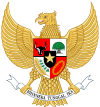| Second Development Cabinet Kabinet Pembangunan II | |
|---|---|
29th Cabinet of Indonesia | |
| 1973–1978 | |
 | |
| Date formed | 28 March 1973 (1973-03-28) |
| Date dissolved | 29 March 1978 (1978-03-29) |
| People and organisations | |
| Head of government | Suharto |
| No. of ministers | 22 ministers |
| Member parties | |
| Status in legislature | Coalition |
| History | |
| Predecessor | Development I Cabinet |
| Successor | Development III Cabinet |
| ||
|---|---|---|
|
Pre-presidency
Rise to power
New Order Domestic policy Foreign policy Downfall
Post-presidency Family
 Gallery: Picture, Sound, Video
Gallery: Picture, Sound, Video |
||
The Second Development Cabinet (Indonesian: Kabinet Pembangunan II) is the name of the cabinet of the Indonesian government led by President Suharto and Vice President Hamengkubuwono IX. The cabinet was announced on 27 March 1973 and served from 28 March 1973 until 29 March 1978.
The Sapta Krida (tasks) of Second Development Cabinet are as follows:
- Maintaining and enhancing political stability.
- Maintaining and enhancing security and order stability.
- Maintaining and enhancing economic stability.
- Completing Repelita I and then preparing and implementing Repelita II.
- Improving people's welfare.
- Improving the order and utilization of apparatus.
- Holding general elections at the end of 1977.
During this cabinet period, The Second Pelita began (1 April 1974 – 31 March 1979). The targets to be achieved at this time are food, clothing, housing, facilities and infrastructure, welfare for the people, and expanding employment opportunities. The Second Pelita succeeded in increasing the economic growth of an average population of 7% a year. Improvements in terms of irrigation. There was also an increase in production in the industrial sector. Then many roads and bridges were rehabilitated and built.
Also during this cabinet period, the Malari incident (Fifteenth of January Catastrophe) occurred on 15–16 January 1974 which coincided with the arrival of Japanese Prime Minister Tanaka Kakuei to Indonesia.
Cabinet leaders
| President | Vice President | ||
|---|---|---|---|
| Suharto | 
|

|
Hamengkubuwono IX |
Cabinet members
Ministers
The following are the ministers of the Second Development Cabinet.
Officials with ministerial rank
The following are ministerial-level officials in the Second Development Cabinet.
| Num. | Portfolio | Photo | Minister | Took office | Left office |
|---|---|---|---|---|---|
| 1 | Attorney General | 
|
Ali Said | 4 April 1973 | 18 February 1981 |
| 2 | Governor of the Central Bank | 
|
Rachmat Saleh | 4 April 1973 | 5 April 1978 |
| 3 | Commander of the Operational Command for the Restoration of Security and Order (KOPKAMTIB)/Deputy Commander of the ABRI | 
|
Sumitro | 4 April 1973 | 2 March 1974 |

|
Soeharto | 2 March 1974 | 29 March 1978 |
Notes
- ^ Adam Malik was appointed chairman of the MPR/DPR-RI. And Mashuri Saleh was sworn in as a member of the DPR/MPR-RI for the period 1977–1982.
- Oemar Senoadji was appointed Chief Justice of the Supreme Court of Indonesia.
- Ali Wardhana was actually sworn in on 28 March 1973, but was sworn in only because he was serving abroad at that time.
- Passed away in office.
- Sumitro resigned from his position as Pangkopkamtib.
- Since 2 March 1974, but who carried out his duties was Admiral Sudomo.
References
Book
- Simanjuntak, P. N. H. (2003), Kabinet-Kabinet Republik Indonesia: Dari Awal Kemerdekaan Sampai Reformasi (in Indonesian), Jakarta: Djambatan, pp. 332–344, ISBN 979-428-499-8.
- Winarno, Bondan. 2013. J.B. Sumarlin Cabe Rawit yang Lahir di Sawah. Jakarta: PT Kompas Media Nusantara
Newspapers and others
| National Revolution (Presidential) |  | |
|---|---|---|
| National Revolution (Parliamentary) | ||
| United States of Indonesia |
| |
| Liberal Democracy | ||
| Guided Democracy | ||
| New Order | ||
| Reform Era | ||

























